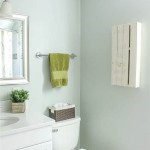How to Put Up Backsplash in a Bathroom
A backsplash adds a touch of elegance and functionality to any bathroom. It protects the walls from splashes and moisture, while adding visual interest and style to your space. Installing a backsplash yourself can be a rewarding DIY project that saves you money and allows you to personalize your bathroom. This guide will walk you through the process step by step, making it easier than ever to upgrade your bathroom with a stunning backsplash.
1. Preparation and Planning
Before you begin, it’s crucial to plan and prepare your workspace. This step involves gathering materials, taking measurements, and ensuring the area is ready for installation.
- Measure the area: Determine the area you want to cover with the backsplash and take accurate measurements of the height and width. This will help you calculate the amount of tile and grout needed.
- Choose your materials: Select the type of tile that best suits your bathroom's style and budget. Consider factors such as size, shape, color, and material. You'll also need mortar, grout, thinset, a trowel, a tile cutter, a level, a sponge, and safety gear like gloves and goggles.
- Prepare the wall: Ensure the wall is clean, dry, and free of any loose paint, wallpaper, or debris. If necessary, use a drywall compound to fill in any cracks or imperfections and allow it to dry completely.
- Install the backer board: A backer board is a moisture-resistant sheet that provides a stable base for the tile. It can be attached to the wall using construction adhesive and screws.
2. Installing the Tiles
Once the wall is prepared, you can begin installing the tiles. This requires careful attention to detail and precision to ensure a smooth and even finish.
- Layout the first row: Using a level, mark the center of the wall, and create a straight line for your first row of tiles. This will serve as a reference point for the rest of the installation.
- Apply thinset mortar: Spread a thin layer of thinset mortar onto the backer board using a trowel. The thickness of the layer should be consistent throughout.
- Attach the tiles: Place the tiles onto the thinset, pressing them firmly into place. Use spacers between the tiles to ensure even grout lines.
- Continue tiling: Work your way up the wall, ensuring that each row is level and aligned with the previous one. Always check your work using a level.
3. Grouting and Finishing
After the tiles have set, you can apply the grout to fill in the spaces between them. This adds strength and a polished look to your backsplash.
- Apply grout: Using a grout float, apply grout between the tiles, making sure to fill all the spaces completely.
- Clean the grout: Wipe away excess grout with a damp sponge, ensuring that the grout lines are clean and smooth.
- Seal the grout: Once the grout has dried completely, apply a grout sealer to protect it from moisture and stains. This will make the grout easier to clean and maintain.
- Clean and inspect: Remove any remaining grout residue and inspect the backsplash for any imperfections or areas that need attention.
By following these steps, you can successfully install a backsplash in your bathroom. Remember to take your time, work carefully, and always prioritize safety. With a little effort and attention to detail, you'll be able to create a stunning and functional backsplash that enhances the beauty and practicality of your bathroom.

How To Install Backsplash Bathroom Tile Easy Simple

How To Install A Tile Backsplash

How To Install A Backsplash On Vanity Bowed Wall

Small Bathroom Remodel Easy Diy Tile Backsplash Engineer Your Space

Small Bathroom Remodel Easy Diy Tile Backsplash Engineer Your Space

How To Install A Backsplash On Vanity Bowed Wall

Removable Tile Backsplash For Bathroom Vanity B4 And Afters
Backsplash Advice For Your Bathroom Would You Tile The Side Walls Too Designed

Removable Tile Backsplash For Bathroom Vanity B4 And Afters
Backsplash Advice For Your Bathroom Would You Tile The Side Walls Too Designed
See Also







